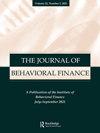公司发起的推文对股票收益和交易量的影响
IF 1.7
3区 经济学
Q3 BUSINESS, FINANCE
引用次数: 4
摘要
美国证券交易委员会最近的指导方针使许多财富500强公司积极采用社交媒体,如Twitter,传播信息。本文分析了公司推文与股票收益之间的关系。我们的研究使用了道琼斯工业平均指数30家公司在2013年4月至2020年7月期间发布的120多万条企业推文。企业推特频率的冲击对股票收益和交易量有正向影响。因此,我们使用向量自回归模型来检验企业推文频率、股票收益和交易量变化之间的因果关系和脉冲响应。我们的研究结果表明,43%的股票在公司发起的推文与交易量变化之间表现出格兰杰因果关系。我们发现了与Barber和Odean提出的注意力诱导价格压力假说相一致的证据。我们观察到,企业推特行为的冲击分别对73%和60%的股票的交易量和回报变化产生了积极影响。这些结果对于制定适当的社交媒体传播策略具有重要意义。这些发现对投资者和交易员也很有价值,他们可以利用企业推文部署预测模型,以获得更高的回报。本文章由计算机程序翻译,如有差异,请以英文原文为准。
Impact of Firm-Initiated Tweets on Stock Return and Trading Volume
ABSTRACT Recent SEC guidelines enabled many Fortune 500 companies to actively adopt social media, such as Twitter, to disseminate information. In this paper, we analyze the relationship between tweets by corporations and stock returns. Our study used over 1.2 million corporate tweets made by thirty companies in the Dow Jones Industrial Average between April 2013 and July 2020. The shocks from the frequency of corporate tweets can positively impact stock returns and trading volume. We, therefore, examine causality and impulse response between frequency of corporate tweets, stock returns, and changes in trading volume using a vector autoregression model. Our findings indicate that 43 percent of stocks exhibit Granger causality between firm-initiated tweets and changes in trading volume. We find evidence consistent with the attention-induced price pressure hypothesis proposed by Barber and Odean. We observe that a shock in corporate tweeting behavior translates into a positive effect on changes in trading volume and returns in 73 percent and 60 percent of stocks, respectively. These results are significant for developing appropriate social media communication strategies. The findings are also valuable for investors and traders who can deploy forecasting models utilizing corporate tweets to earn superior returns.
求助全文
通过发布文献求助,成功后即可免费获取论文全文。
去求助
来源期刊

Journal of Behavioral Finance
Multiple-
CiteScore
4.60
自引率
10.50%
发文量
34
期刊介绍:
In Journal of Behavioral Finance , leaders in many fields are brought together to address the implications of current work on individual and group emotion, cognition, and action for the behavior of investment markets. They include specialists in personality, social, and clinical psychology; psychiatry; organizational behavior; accounting; marketing; sociology; anthropology; behavioral economics; finance; and the multidisciplinary study of judgment and decision making. The journal will foster debate among groups who have keen insights into the behavioral patterns of markets but have not historically published in the more traditional financial and economic journals. Further, it will stimulate new interdisciplinary research and theory that will build a body of knowledge about the psychological influences on investment market fluctuations. The most obvious benefit will be a new understanding of investment markets that can greatly improve investment decision making. Another benefit will be the opportunity for behavioral scientists to expand the scope of their studies via the use of the enormous databases that document behavior in investment markets.
 求助内容:
求助内容: 应助结果提醒方式:
应助结果提醒方式:


